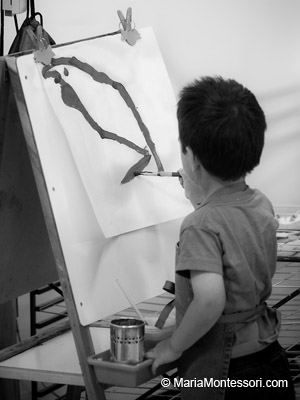October 30, 2022
It begins with the increasingly noisy tap–tap–tapping of brush on a bucket, that first signal of digging in and lying low and simultaneously signaling readiness for the potential struggle to come. This is soon accompanied by nonsense chatter and noises. “How quickly we can get into these cycles, “ the guide thinks to herself.

This child loved to paint at the easel, reaching all the corners of the paper with the brush dripping with paint, outstretched from his almost three-year-old body. But he did not enjoy the cleanup. To his mind, the work was done when the painting was done, and that was that. The guide quietly admired the pluck of a child who would repeatedly select a work for which he had a great fondness, yet remain steadfast in his disdain for the cleanup.
Leaving her chair and willing her body to sail slowly across the room at a stately and steady pace, the guide approaches the child, now wild in the eye and poised for flight or fight – he has been here before. She stops within earshot and quietly stands and waits, offering her calm centeredness to the agitated child. Experienced in the ways of those who love the work but do not relish the wrap-up, she has decided it is time to switch tactics. Unlike most of the children, who respond willingly and quickly to her approach to upholding the limits, customs, and expectations of the structure inherent in the freedoms offered in the environment, she recognizes that this child has quickly built up resistance to them and stands in fierce opposition.
“You have painted a picture, Jim!” she says with warmth and an admiring twinkle in her eyes. “It is full of lovely red paint and a nice dot of white right here,” she offers in his direction, taking care to avoid any sign of discontent that, again, this boy is not ready to assume the last part of the cycle – the cleanup.
“Let’s hang it up together!” Unclipping the sopping wet painting from the easel, she makes a mental note to refer to Rothko when speaking of Jim’s passion for painting at his next parent conference and invites the child to hold a corner of the paper. Fetching a clothespin, she deftly attaches her end to the wire and, turning to the boy, realizes he is trying to fasten his end with an upturned clothespin. “Oh,” she exclaims, “these can be tricky,” as she fetches another pin and slowly demonstrates how to hold it and squeeze the appropriate ends. She waits quietly and patiently until his persistent efforts end in success.
“I can help you clean up when you are ready,” she offers. She wrestles mightily with herself, remembering his usual unpleasant resistance – extending even to screaming, hitting, and kicking – to any expectation that he follow through with cleanup. She chooses instead to focus on her new plan for engaging the boy, pausing to allow him to consider her offer. “I will fetch my sponge when you are ready.”
She is now crouching low, near enough for intimacy and connection but respectful of the boy and his readiness. Her experience is that it can go either way, depending upon her ability to convey to him her desire to join him in transforming what has previously been a stressful activity into a joyful partnership. She recognizes the importance of this moment in his developing independence and trusts that enticing collaboration and cooperation will be the bridge that will encourage self-will – another step toward becoming a person who relishes all parts of the work he chooses.
Engaging the youngster in this work, she suggests, “Shall I fetch the bucket of water or shall you?” Throughout the cleaning up she offers choices and opportunities for cooperation: “Shall we begin at the top of the easel or the bottom and wash it? Shall I do the top part and you the lower part? Now let me show you how to give the blue brush a bath, and then you can choose a brush to bathe.”
In this way, they continue the process of restoring the easel and its surroundings to order. Nearing the end of it, she says quietly and conspiratorially, “We make a good team, Jim. How clean and beautiful this easel is! And now the easel is ready for the next child!”
“And that could be me!” the boy exclaims. “I could be the next child!”
She smiles inwardly in recognition of a step closer for him to assume all the responsibilities inherent in work and a step closer for her to be able to truly enjoy and appreciate Jim, no matter what. Soon, her experience whispers, he will be ready and able to clean it all up by himself. She has been here before.